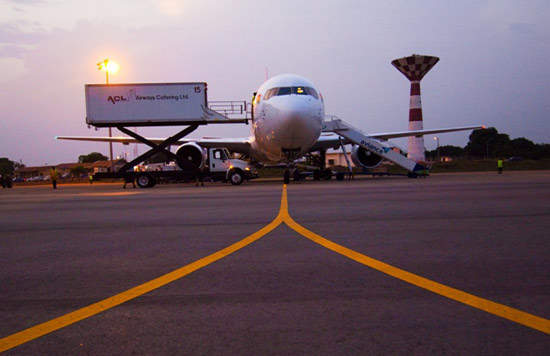Kotoka International Airport serves Accra, the capital of Ghana. The massive expansion in usage of the airport has led to calls for an upgrade. Passenger usage increased by an average of six percent per annum throughout the 1990s and cargo usage has risen by as much as 15% per annum. Such a phenomenal rate of growth has forced further expansion in the airport facilities to keep pace.
The latest improvements to the airport are part of an ongoing programme. The first phase was financed through international development funding sources and was completed in 1993. The second phase was financed from commercial revenues, with the aid of the UK export credit guarantee agency.
The sponsor of the airport improvement programme is the Ghana Civil Aviation Authority (GCAA), which is an agency of the Ghanaian government. The government’s backing and the involvement of foreign development agencies are linked to the airport’s importance and to the Ghanaian economy as a whole. In 2004, the airport was able to process around 800,000 passengers.
The airport is operated by the Ghana Airports Company, which is responsible for all the country’s airports, including Tamale, Kumasi and Takaradi. The airport is open 24 hours a day and serves a number of airlines, including KLM Royal Dutch Airlines, Ghana International Airways, Egypt Air and Middle East Airlines.
PROJECT MAKE-UP
Firms that bid for Phase 2 included Bouygues and Dumez from France, Fitzpatrick and Taylor Woodrow of the UK, Bilfinger & Berger from Germany, Dragados from Spain, Skanska from Sweden and Vermeer from the Netherlands. Siemens Plessey, which carried out the first phase in the early 1990s, chose not to bid for the second phase.
The Swedish contractor, Skanska, and its consortium, won the contract. The total contract was worth SEK 590 million ($74 million) and Skanska’s share was about 40% (just under $30 million). Skanska International Construction pursued the project through Skanska Jensen International, which managed the consortium comprising the local branch of an Irish civil engineering company, PW Ghana and the Danish Intertec.
PHASE 2
The second phase of the airport improvement originally involved the renovation and expansion of the terminal buildings, fire station and cold-storage facilities as well as the renovation and construction of new platforms. The fire station, cold-storage facilities and taxiway upgrade were all removed from the expansion programme in order to concentrate funding on the terminal buildings.
Improvements to the terminal buildings included the refurbishment and enlargement of the departure check-in area, incorporating new conveyors and other equipment to improve passenger handling and comfort as well as the installation of air conditioning in the immigration area. The communication facilities in the terminal were also be renovated. The baggage handling hall for arrivals was given a new conveyor system in order to maximise efficient throughput and the terminal forecourt was remodelled with a dual carriage way, departure and arrival vehicular areas, and car parks. The facilities for ‘meeters and greeters’ were also improved to make the airport seem less congested.
The 03-21 runway (11,165ft, 3,403m) was extended by 150m at the 03 stopway and 400m at the 21 end threshold, to allow a fully laden 747 to take off. This greatly enhances Kotoka’s ability to handle air freight.
THE CURRENT STATE OF THE AIRPORT
Most of the project’s Phase 2, which included the new departure and arrival terminals, opened in 2004. However, due to a lack of funds the covered gangways, through which passengers would access the planes, was not completed. Because of this the airport still uses shuttle buses to move their passengers from the departure gates to the aircrafts. The departure area has been significantly improved. There are 15 check-in desks available, two gates and three baggage claim areas. There is also a VIP lounge, a number of restaurants and a variety of retail outlets.
AIRPORT CITY
In 1998, the GCAA announced plans to develop the 40 plus acre site in front of the airport as an ‘airport city’. This involves the development of roads, communication facilities, power distribution, lighting, water supply, sewage treatment, parking lots, landscaping, drainage, walkways and other ancillary works. The lots on the site have been parcelled out among private developers.
FINANCE
The second phase of the project was financed by loans from the Hong Kong Chinese bank HSBC, British Paribas and Ghana’s Ecobank, with support from the export credit organisations ECGD in the UK, EKN in Sweden and EKF in Denmark. The banks provided a $44.5 million loan, which was underwritten by the export agencies. The two Scandinavian agencies are reinsuring ECGD for the supply of equipment from Europe. The UK loan is the largest element to be supplied by any single organisation.





